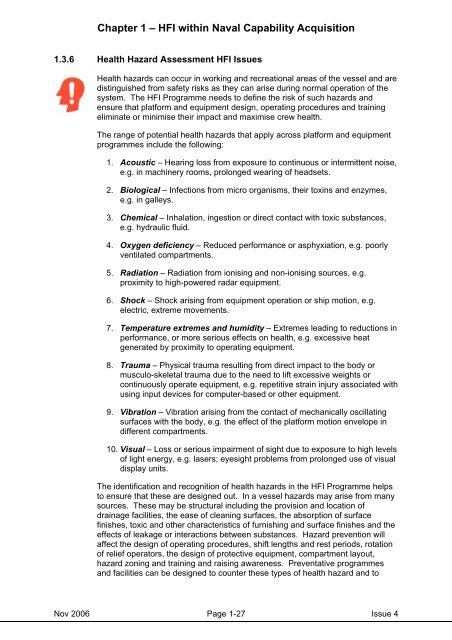MAP-01-010 HFI Management Guide - Human Factors Integration ...
MAP-01-010 HFI Management Guide - Human Factors Integration ...
MAP-01-010 HFI Management Guide - Human Factors Integration ...
Create successful ePaper yourself
Turn your PDF publications into a flip-book with our unique Google optimized e-Paper software.
Chapter 1 – <strong>HFI</strong> within Naval Capability Acquisition<br />
1.3.6 Health Hazard Assessment <strong>HFI</strong> Issues<br />
Health hazards can occur in working and recreational areas of the vessel and are<br />
distinguished from safety risks as they can arise during normal operation of the<br />
system. The <strong>HFI</strong> Programme needs to define the risk of such hazards and<br />
ensure that platform and equipment design, operating procedures and training<br />
eliminate or minimise their impact and maximise crew health.<br />
The range of potential health hazards that apply across platform and equipment<br />
programmes include the following:<br />
1. Acoustic – Hearing loss from exposure to continuous or intermittent noise,<br />
e.g. in machinery rooms, prolonged wearing of headsets.<br />
2. Biological – Infections from micro organisms, their toxins and enzymes,<br />
e.g. in galleys.<br />
3. Chemical – Inhalation, ingestion or direct contact with toxic substances,<br />
e.g. hydraulic fluid.<br />
4. Oxygen deficiency – Reduced performance or asphyxiation, e.g. poorly<br />
ventilated compartments.<br />
5. Radiation – Radiation from ionising and non-ionising sources, e.g.<br />
proximity to high-powered radar equipment.<br />
6. Shock – Shock arising from equipment operation or ship motion, e.g.<br />
electric, extreme movements.<br />
7. Temperature extremes and humidity – Extremes leading to reductions in<br />
performance, or more serious effects on health, e.g. excessive heat<br />
generated by proximity to operating equipment.<br />
8. Trauma – Physical trauma resulting from direct impact to the body or<br />
musculo-skeletal trauma due to the need to lift excessive weights or<br />
continuously operate equipment, e.g. repetitive strain injury associated with<br />
using input devices for computer-based or other equipment.<br />
9. Vibration – Vibration arising from the contact of mechanically oscillating<br />
surfaces with the body, e.g. the effect of the platform motion envelope in<br />
different compartments.<br />
10. Visual – Loss or serious impairment of sight due to exposure to high levels<br />
of light energy, e.g. lasers; eyesight problems from prolonged use of visual<br />
display units.<br />
The identification and recognition of health hazards in the <strong>HFI</strong> Programme helps<br />
to ensure that these are designed out. In a vessel hazards may arise from many<br />
sources. These may be structural including the provision and location of<br />
drainage facilities, the ease of cleaning surfaces, the absorption of surface<br />
finishes, toxic and other characteristics of furnishing and surface finishes and the<br />
effects of leakage or interactions between substances. Hazard prevention will<br />
affect the design of operating procedures, shift lengths and rest periods, rotation<br />
of relief operators, the design of protective equipment, compartment layout,<br />
hazard zoning and training and raising awareness. Preventative programmes<br />
and facilities can be designed to counter these types of health hazard and to<br />
Nov 2006 Page 1-27 Issue 4
















